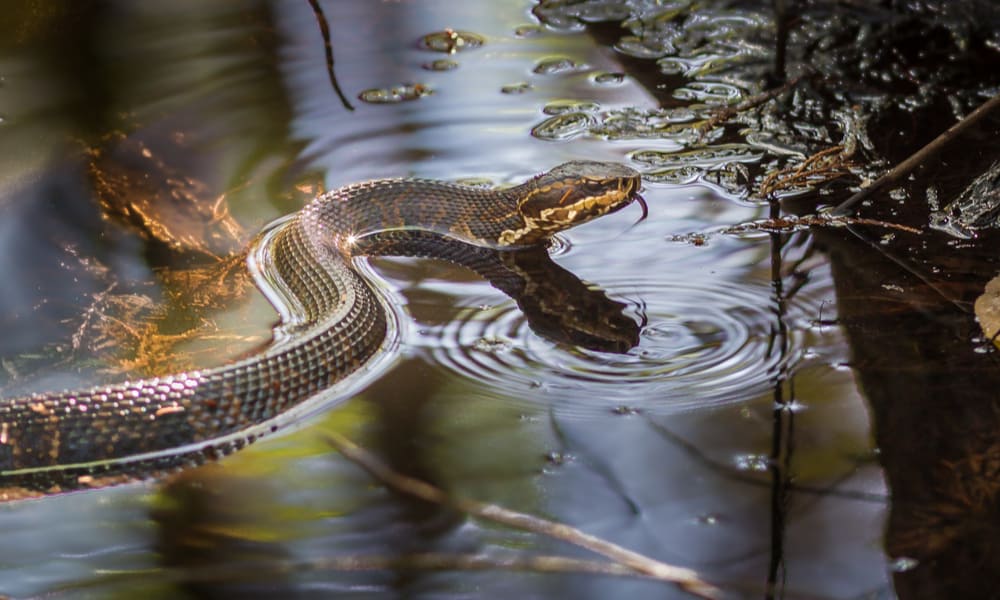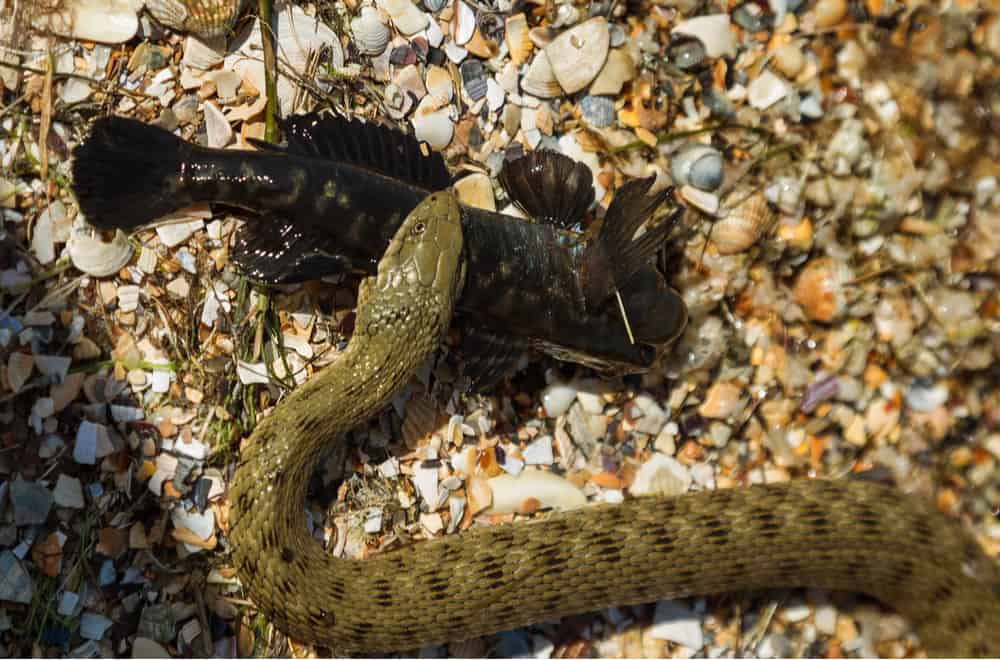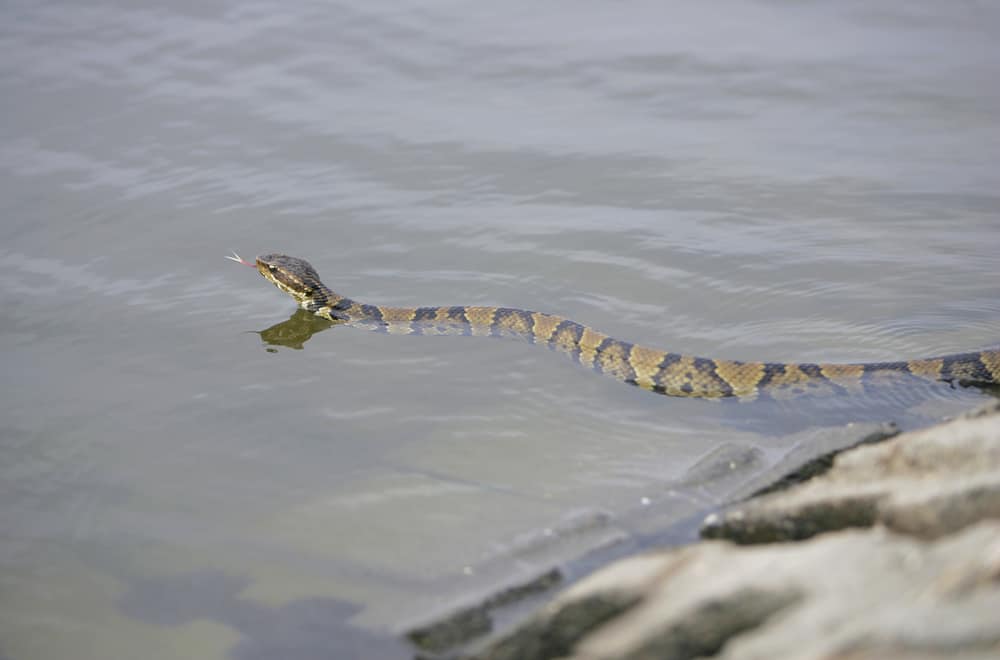Water moccasin or cottonmouth is a snake species found in various places in Florida and the southeast US. Most locals recognize it, and it is particularly known for its strong venom. Its bite is very painful and can cause death even to humans and larger animals.
In this article, we will answer the question, “What do water moccasin eat?”
Water Moccasins Habits and biology
You can differentiate these snakes as they are almost completely or completely black. The only exception is their head. Besides this color, they might also have gray, brown, yellow-olive, tan sections. In addition, the lower side of their hide might have a tan, cream, and white tones.
As mentioned, you can spot them in various places in the southeast US. One of their largest breeding grounds is Virginia’s Great Dismal Swamp. You can find them in areas from Arkansas to the West, to all the way north to Indiana. The water moccasin is a common inhabitant of swamps, marshes, creeks, streams, lakes, and other bodies of water.
They are great swimmers but can also be found on the ground. In fact, they can live their whole lives in an environment with little moisture, and they would have no trouble. For example, some of them inhabit pine woods, dunes, and palmetto thickets in Texas.
Here are some of their most common habits:
- Cottonmouths usually live alone.
- The snake can be active both during the days and during the night. But, if it’s a sunny day, they might coil themselves in the shade. The animal loves sunlight and can often be found in the open.
- This animal is very proficient in the water and can bite while submerged.
- In colder parts of the country, it is common for cottonmouths to hibernate during the winter. In the south, the hibernation cycle is much shorter, or they might not hibernate whatsoever. While hibernating, they usually occupy various burrows that belong to other animals. You can also find them in rotting stumps, wooden hillsides, and other types of cover.
- The water moccasin is not particularly aggressive. But when threatened, it might put itself in a characteristic position where it will rise and open its mouth. That way, cottonmouth shows the interior of its mouth. It will also rattle its tail.
What do water moccasins eat in the wild?
The water moccasin is very adaptable. Nature allowed this species to hunt both on the ground and in water, which is why it has such diverse prey. When hunting animals, the snake will first kill it with its bite, and then, it will wrap its body around the prey until it stops moving. Cottonmouth eats animals whole.
The species have two methods for hunting prey. Most of them hunt by simply chasing an animal and killing it. Alternatively, they can catch prey by lying in wait. The snake’s skin is ideal for ambushing as it can easily meld with its environment. Once the unfortunate animal is close enough to its position, water moccasin will quickly leap out of its cover and bite it.
Baby water moccasins use another interesting method of hunting. They will wiggle their tail to imitate worms, thus attracting unsuspecting frogs. Of course, given that the animal eats prey whole, it will always target species small enough to swallow.
After biting the prey, they will release it. Even if the animal tries to escape, the sharp pain and venom will incapacitate within moments. They don’t necessarily have to follow the animal as they are able to find it by its smell.
Here are some of the main things this species eats:
- Lizards
- Frogs
- Amphibians
- Turtles
- Baby alligators
- Small snakes
- Birds
- Fish
- Small mammals
Like many other species, cottonmouth requires a large quantity of protein. They also depend on nutrients and vitamins, in particular, calcium. The snake gets most of these things through diet and will additionally get it from sunlight.
The species is an opportunistic eater and can eat a lot of different animals. Water moccasins that live in the north are especially dependent on food before hibernation. Like other animals that sleep during the winter, they will try to consume as much as possible beforehand, thus creating energy reserves.
Facts about water moccasins
Cottonmouth is one of the more widespread and recognizable snake species. It is a local symbol in many parts of the US. Here are some intriguing and fun facts about the anima:
- When swimming, the water moccasin will look as it’s crawling on water. This is because they are very light, so their body will float on the surface. However, they can dive and catch underwater prey.
- We categorize all species from this family as pit vipers. This is because they have pronounced facial features, that is, facial pits. These pits are between nostrils and eyes, and they allow cottonmouth to detect heat from other animals.
- While water moccasin can hunt during the day, that still prefer night. The species have different methods of hunting depending on the animal they’re trying to catch. So, when they’re catching fish and frogs, they will hold them in jaws until venom seeps into their bloodstream, and they stop moving. On the other hand, they will bite mammals and let them go. This is because mammals are more likely to fight back and have better defensive mechanisms.
- Although the animal is highly poisonous, its bite rarely causes human death. Interestingly enough, this is the only poisonous water snake in the US. Unfortunately, like many other snake species, humans scrutinize and demonize this animal.
- Often, people cannot differentiate between cottonmouth and other non-venomous swimming snakes. To tell the difference, you need to assess the animal’s buoyancy. The water moccasin is very buoyant, allowing its body to almost float. Most other snakes will be deep in the water, and only their heads will emerge.
- One specific thing about this species is that they tend to rattle their tail when feeling threatened. But they don’t have a rattle that would create a sound like some other snake species do.
- Even though they are very venomous and represent a threat for most species, they are far from aggressive. In fact, they are more likely to flee from humans and larger animals instead of engaging them. The only exception is mothers protecting their nests.
- Besides its ability to sense heat, the species relies on its other senses to catch the prey. They will use a combination of smell, touch, vision, and sound during the hunt. For example, they start by locating the animal with its eyes. Then, a strong sense of touch and hearing allows it to analyze the surrounding. Cottonmouth’s smell is by far its strongest sense; the animal sticks its tongue to find potential prey in the vicinity and detect potential dangers.
- The species primarily mate between April and May. However, they can breed during the whole year. According to experts, they are a monogamous species.
- Like many other animals, water moccasin has a very interesting way of attracting females. They perform a unique combat dance by slithering back and forth. They will also rattle its tail to lure a female. Often, they will fight with other males for female affection.
- The water moccasin is ovoviviparous. In other words, their young are born alive, as the animal can store the eggs in its body until they hatch inside. A female can give birth to five to nine baby snakes. On some rare occasions, they might have up to 20 young. The gestation period lasts for five months.
- It is worth noting that this species is not threatened or endangered in any way. Its population seems stable in most parts of the US, and its numbers haven’t dwindled in any states. Biologists classify water moccasin in three subspecies: Florida cottonmouth, Western cottonmouth, and Eastern cottonmouth.
- Both “water moccasin” and “cottonmouth” have to do with the animal’s physical traits. We call the animal water moccasin because of how it looks on the water. Furthermore, Native Americans have made shoes from their skin. We refer to it as cottonmouth because of its mouth interior. Depending on where you live, you might have heard other names such as gapper, viper, swamp, or black moccasin.
- While very poisonous, there are animals that cottonmouth has to be weary of. It is hunted by snapping turtles, kingsnakes, alligators, cranes, and herons. To escape them, the animal sprays a strong musk in the direction of a predator. They can expel the musk 5 feet away.
- The water moccasin is a very beautiful snake species. However, as it grows older, it will start losing its shinier colors. Instead, its skin will become progressively darker. As they approach death, their upper side will become ruddy black. This will create a major contrast with its white underside. They will also lose the color of their tail tip.
Summary
The water moccasin is the only venomous water snake in the US. In the past, people hunted animals for their beautiful skin. However, it is not endangered in any way, shape, or form.
Cottonmouth is a very solitary species that breeds live young. Water moccasin hunts its prey in several ways and is very proficient in both water and on the ground.


